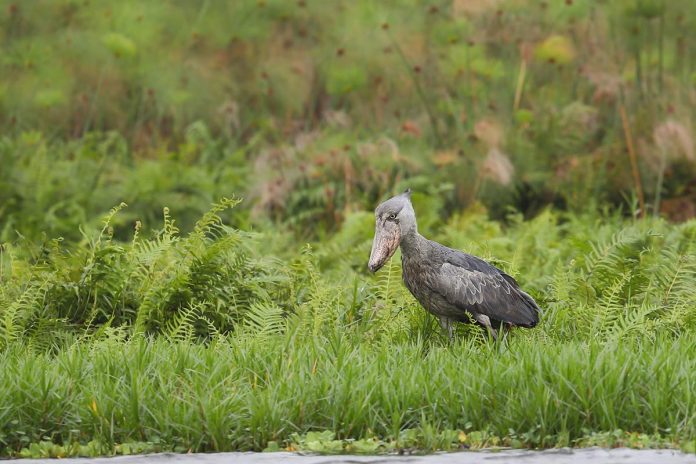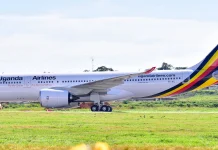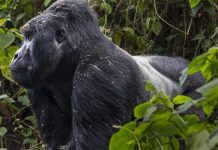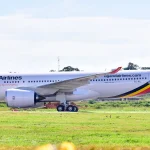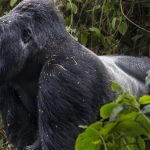The Toro Semliki Wildlife Reserve sits in the western region of Uganda, spanning across Ntoroko and Kabarole districts. Originally established as a game reserve in 1926, it covers an area of 542 square kilometers. The reserve is set in a striking rift valley landscape, nestled between the Rwenzori Mountains, Kijura Escarpment, and Lake Albert. It holds particular appeal for bird-watchers due to its diverse avian population. With an impressive checklist, the reserve boasts many birding specials, including species endemic to the Albertine Rift.
Climate and weather
The climate in Toro-Semliki Wildlife Reserve is consistently hot throughout the year. Daytime temperatures hover around 30°C/86°F, while nighttime temperatures drop to about 18°C/64°F. Unlike some other places, Toro-Semliki does not have a distinct dry season. Instead, rain can occur unpredictably at any time. However, the area experiences two distinct Wet seasons: one from March to May and another from August to November.
Vegetation of Toro Semliki Wildlife Reserve
The dominant vegetation type in the wildlife reserve is open acacia-combretum woodland and grassy savannah. This landscape is punctuated by patches of Borassus palm forest, extensive belts of riparian woodland along the main watercourses, and large swamps near Lake Albert. Although the reserve itself does not boast remarkable topography, sitting at a relatively low altitude of around 700 meters above sea level, on clear days, visitors can enjoy breathtaking views. To the east, the Rift Valley escarpment rises sharply from the shores of Lake Albert, while the 2500-meter-high Congolese Blue Mountains grace the western horizon. Additionally, the glacial peaks of the Rwenzori Mountains are visible to the southwest, adding to the scenic beauty of the reserve.
Wildlife in Toro Semliki Wildlife Reserve
Toro-Semliki National Park is home to many of the same major species found in Queen Elizabeth and Murchison Falls National Parks. Among these are warthogs, elephants, waterbuck, buffalo, Uganda Kob, giant forest hogs, and hippos. Additionally, the park hosts a variety of primates, including chimpanzees, red-tailed monkeys, baboons, black and white colobus monkeys, and vervet monkeys.
One notable feature of the elephant population in the reserve is its diversity, comprising both savannah and forest elephants, as well as a hybrid type resulting from inbreeding. This unique aspect adds to the richness of wildlife experiences available to visitors exploring Toro-Semliki National Park.
Activities done in Toro Semliki Wildlife Reserve
Birding
Toro-Semliki Wildlife Reserve is a home for approximately 460 bird species. Birdwatching enthusiasts can enjoy their hobby in the morning or afternoon, with opportunities to spot a variety of avian treasures. Among the notable species that can be sighted are the elusive shoebill stork, the vibrant red-throated bee eater, the striking Luhders Bushrike, the exquisite Tropical Boubal, the distinctive Black-billed Barbet, the majestic Abyssinian Ground-hornbill, the Arrow-marked Babbler, the elegant Black-headed Bushshrike, and the agile Red-necked Falcon.
These birds can be observed during nature walks or boat rides on Lake Albert. Moreover, from November to April, the reserve welcomes migratory birds, enhancing the diversity of avifauna. Due to its proximity to Semliki National Park, visitors also have the opportunity to encounter various Congolese rainforest species, enriching the birdwatching experience in Toro-Semliki Wildlife Reserve.
Boat ride on Lake Albert

Two boat cruises are available on Lake Albert, one at dawn and another at sunset, primarily sought after by birdwatchers eager to spot the elusive shoebill stork. These majestic birds often conceal themselves among the papyrus and weeds along the marshy shorelines. Additionally, bird enthusiasts may have the opportunity to observe other avian species such as the African Pygmy Goose, Blue-breasted and Blue-cheeked Bee-eaters, and Blue-headed Coucal.
The morning boat safari, considered the highlight of the experience, is offered by lodges and the wildlife reserve.
Primate walk
The chimpanzee population in Toro Semliki Wildlife Reserve is of particular scientific interest because they inhabit a drier environment compared to those in Kibale, Budongo, or Kyambura. This means they must travel longer distances to find food and have been observed walking on their hind legs for short distances.
During the chimpanzee trekking, which typically lasts 3–4 hours, you will be accompanied by a ranger guide who will lead you through riparian and acacia woods, Borassus palm forests, and savannah grasslands. It’s important to note that chimpanzees in this area are less habituated compared to those in other habitats.
In addition to chimpanzees, visitors may also encounter other primate species such as vervet monkeys, black and white colobus monkeys, red-tailed monkeys, and olive baboons.
Hiking Nyaburogo gorge
The hike begins at the park headquarters and covers a distance of 7km, leading through diverse habitats such as savanna grassland, woodland, and a forest in the gorge. This trail is popular among birdwatchers, offering opportunities to spot various bird species including the Luhdrers Bushrike, Tropical Boubal, Black-headed Bushshrike, and Arrow-marked Babbler.
Along the way, hikers may also encounter primates such as black and white colobus monkeys, vervet monkeys, and olive baboons. While rare, there is a possibility of spotting chimpanzees as well.
Best time to visit Toro Semliki Wildlife Reserve
It’s essential to consider the timing of your visit to Toro-Semliki due to its hot climate, where temperatures drop significantly after sunset and there’s a constant threat of rain. Despite experiencing heavy rainfall during its two wet seasons (March to May and August to November), the relief from the heat is minimal, particularly in March to May when local roads may become impassable due to flooding.

The dry seasons (December to February and June to July) offer somewhat drier conditions, making it more comfortable for visitors. Animal watching is particularly rewarding during these periods, as there is abundant sunshine, rare rainfall, and animals tend to gather around water sources, facilitating wildlife sightings. Bird enthusiasts will also find these months ideal for birdwatching, especially from January to March. Additionally, monkey trekking is recommended during the mid-year dry season (June to July).
However, for the remainder of the year, visitors should anticipate heavy rainfall and should come prepared with appropriate wet-weather clothing. Some routes may become inaccessible during the wetter months due to flooding.
How to get to Toro Semliki Wildlife Reserve
By road transport, there are two routes to choose from. The first route is via Kampala and Fort Portal through Mubende, passing by Kibale National Park, covering a distance of 290 kilometers and taking approximately 6-7 hours to drive. The second route is longer, approximately 465 kilometers, and passes through Masaka, Mbarara, and Kasese. This route offers many tourist attractions along the way, including Lake Mburo National Park, Igongo Cultural Village, and Queen Elizabeth National Park. Upon reaching Fort Portal, travelers should take the Semuliki National Park route for the initial 28 kilometers, then turn right at Karugutu trade town, leading to Toro Semliki Wildlife Reserve, which takes about 1 hour to drive.
Alternatively, travelers can opt for air transport by booking chartered flights from Entebbe International Airport or Kajjansi Airfield. Companies such as Aerolink and Bar Aviation offer regular flights to the airstrip at Toro Semliki Wildlife Reserve, managed by UWA.
Entry fee for Toro Semliki Wildlife Reserve
The entry fee for Foreign adults is USD $35. Driving or walking along the main road to Bundibugyo, just beyond the park’s southeastern boundary, or staying overnight at Bumaga Visitor Camp is free of charge. However, since Semliki National Park and Toro-Semliki Wildlife Reserve are independent entities, travelers who visit both must pay two sets of entry fee, even if they do so within the same 24-hour period.
